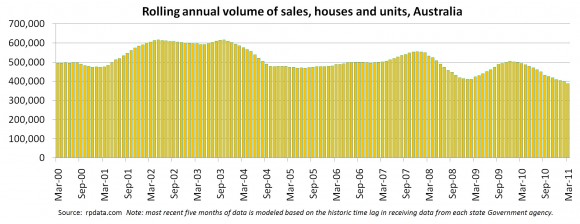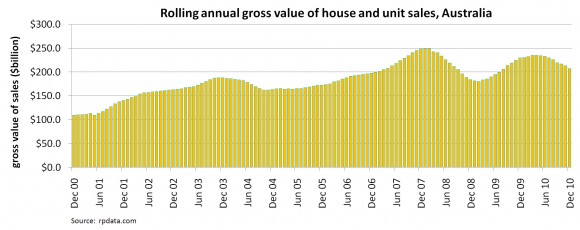Myself and the Unconventional Economist talk a lot about the housing in Australia. But it isn’t really housing itself that I see as the issue, it is the every growing private sector debt that supports it that concerns me. It could as easily be Mars bars, tulips or Nespresso coffee machines because from an economic perspective the “product” itself isn’t the concern. It is the ever expanding debt used to purchase that asset that is out-of-whack with its real economic return that is the issue.
While the market for these assets is expanding the additional credit created in the economy drives all kinds of activity. Employment is created by this new money, consumer activity increases and prices rise on the additional money available in the economy. Everyone holding these assets feels richer and therefore is happy to spend instead of save knowing they have their little “nest egg” that will be there in case they need it.
As I explained yesterday, government bodies also get on-board the gravy train, and unsurprisingly industries connected directly to the sale of, provision, support and/or construction of said asset flourish.
Over time asset prices reach a level that is completely out of line with its real economic value which means that the amount of debt required for vendor-profitable transaction in the asset continues to grow. Once the existing credit gets to a point where it is near the top of the serviceability level based on real economic activity, that is wages, then it is only a matter of time before it all comes unstuck. This may take many years, perhaps decades, and usually has one or two false starts, which is why many people convince themselves that this is completely normal.
But one day a limit is reached. Once wages can no longer sustain the debt then everything begins to happen in reverse. Credit issuance rates begin to fall, leading to lower transaction, slowly leading to falling asset values, leading to falling employment… and so on.
Interestingly Tim Lawless from RPData actually talked about this phenomena yesterday on his blog.
Times are tough in the real estate sector, transaction volumes are down, listing volumes are up and buyers are scarce. Not a great combination when you are trying to sell a property.
It stands to reason that fewer property transactions mean less commission for real estate agents. It also means mortgage brokers are establishing less trail, solicitors are involved with fewer conveyances, buyers’ agents have fewer clients, removalists have fewer jobs and pest and building inspectors have less work. The multiplier effect of a property transaction extends to the retail sector where less furniture, white goods and appliances are transacted. And of course the State Government receives less stamp duty which is one of their major sources of tax revenue.
Currently, on a national basis, we estimate that over the year to March 2011 there were about 390,000 house and unit transactions (our transaction volumes are modeled for the most recent five months due based on the typical lag in receiving the full population of transaction data from the respective state governments). Based on these estimates, the rolling annual transaction count hasn’t been this low since 1997. Over the last five years, the average number of sales on an annual basis has been 480,000; so the current annual figure is tracking about 19% below average.
According to the blog post transactions are still being supported by the a high per-transaction value.
But RPData’s own data supports the premise that a continuation of falls in transactions is leading to a fall in overall transaction values, so it seems quite obvious that without a uptick in transaction volumes this problem is going to get worse. It is also obvious from the charts provided by Tim Lawless that there has been a significant fall in the value of work for real estate agents since the first home buyers grant boost ended, and there certainly doesn’t seem to be any driver for that to change in the short term. So it wasn’t much of a surprise to read this report from AFR yesterday.
Ten thousand real estate agents, about one in six, have abandoned the profession in the past year as low sales volumes and falling commissions wipe out their profits. Rising interest rates and poor consumer confidence have made it much harder to sell houses, and figures from the Real Estate Institute of Australia show many more people are leaving the industry than entering it.
Sydney-based Bill Bridges, a 55- year industry veteran, has witnessed plenty of downturns, but “I can’t ever remember it being tougher”.
“I want someone to tell me why it’s going to get better; I can tell you 20 reasons why it won’t,” Bridges says.
“This is a worldwide thing.”
“Some agents are telling you it’s great, but it’s not reflecting in their – figures, I’ll tell you.”
April sales volumes fell nationally by 21 per cent compared with April last year. Big, well-resourced groups such as L J Hooker and Ray White are taking advantage of the downturn to lure the best sales people and pick up business where others fold. The slump and exodus of agents has been more marked in resources-rich Western Australia and Queensland, where housing boomed before the financial crisis.
REIA president David Airey estimates that the number of estate agents nationwide has dropped to 50,000, from 60,000 a year ago. There were 72,000 agents in the 2006 census.
It is fairly obvious from recent data , insurance effected data excluded , that this downturn in credit issuance is already hitting the retail sector. Without an increase in the rate of sales over the coming quarters it will be bankers and loans officers next …. and then onto the broader economy.

